|
Accident on the Buffalo Trail
The Nomadic Van Guzzar Tribe
in Northern India
Article and photos by Michael Benanav
Swirling gray clouds swallowed the mountaintops. A cold rain fell in surges, hard and heavy one minute, just a light patter the next. Two miles above sea level, surrounded by towering rocky slopes, a family camped in a patch of forest just below the treeline. Their three tents of black plastic sheeting, propped up with sticks, were worn and tattered and, at that moment, leaky. Underneath, fresh pine needles were spread, making a clean floor and soft-ish bed.
Just before the accident occurred, a few
women who were caring for the youngest children sat under the
tarps, chatting. Akloo, whose dark eyes and sculpted cheeks were
loosely framed by a green-and-purple headscarf, cradled her year-old
baby, Hasina. Apa, wearing a yellow polyester sweater over a dark
green kameez, her thick black hair tied back but uncovered, brewed
tea over a fire more smoke than flame. Mariam, who at seventeen
was about five years younger than other two, and — depending
on the hour — could look either like a young girl or a mature
woman, was lying down. Covered by a brown fleece blanket, she
was resting but awake enough to giggle and joke with Akloo and
Apa. Everyone else in their family was away from the camp,
keeping a watchful eye on their animals despite the bone-chilling
weather. Nomads from the Van Gujjar tribe, they were on their
annual spring migration, trekking to an alpine meadow high in
the Himalayas of northern India with their herd of water buffaloes.
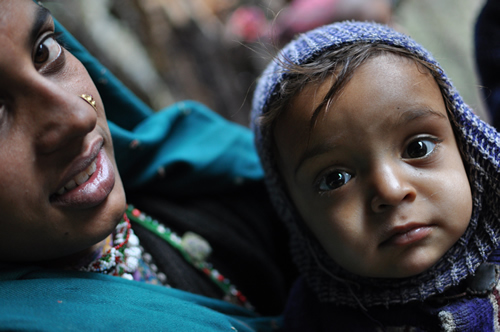
Van Gujjars spend the fall and winter months roaming the lowland jungles of the Shivalik Hills, not far from Dehradun, grazing their herds on the foliage that grows there. But as March turns to April, the Shivaliks get pummeled by heat. Creeks run dry. Parched trees shed their leaves. Once-lush forests wither into wastelands. With nothing left for their buffaloes to eat or drink, Van Gujjar families must leave. They load their belongings onto a few pack animals and hike to the highlands with their herds. There, melting snows reveal grassy fields — called bugyals — laced with streams, plenty to sustain the buffaloes until autumn, when the families descend again to the lowland jungles rejuvenated by summer rains. It's a nomadic cycle that's existed in this part of India for over a thousand years, but may not last for many more, as their ancient lifestyle confronts an array of modern dilemmas. Inspired to experience and document the migration, I traveled the entire route into the Himalayas with one family, hoping to glean an understanding of their way of life and the challenges their culture faces.
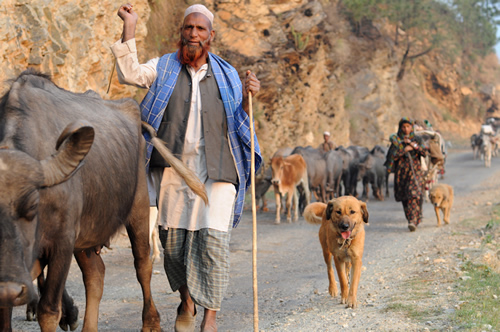
Early on, the family I was embedded with ran into problems. Their traditional bugyal, where they go every summer, has been absorbed into Govind-Pashu-Vihar National Park, and park authorities wanted to ban buffalo herding from this protected ecosystem — even though the degree of environmental impact that nomadic practices have is an unsettled subject of debate. Though they've used it for many generations, "my" family doesn't own this land. Each year they apply for a grazing permit from the state of Uttarakhand, which grants them access to the meadow. This year, for the first time ever, they were denied. It's a tragic irony that the creation of national parks, meant to preserve things fragile and endangered, poses the most immediate threat to the survival of Van Gujjar culture. (Thousands of Van Gujjars were removed from the Shivalik Hills when Rajaji National Park was formed there, and now live non-nomadic lives in government-built villages, their lifestyle radically altered.)
Desperate to find a meadow for their herds, my family — twenty-six people, including infants just a few months old — had to migrate further and higher than usual, over much rougher terrain than they'd expected.
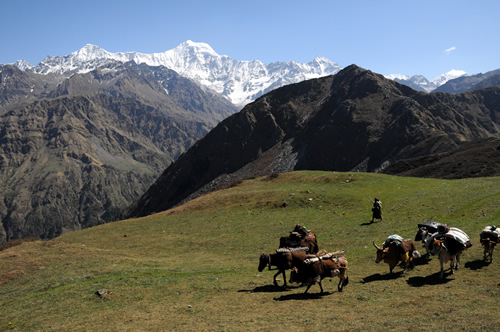
By the time the accident happened, we'd been on the trail for thirty-eight days. Our plastic tarps were pitched just six miles shy of the bugyal where the family would spend the summer. But we still had to climb some 3,000 feet, up and over a mountain pass, so had to wait for the weather to clear.
Most of the family was out in the rain, watching the herds, making sure the buffaloes didn’t wander away or eat any rhododendron, which could be fatally poisonous. The brothers Chamar and Hamju huddled under an umbrella together, their sweaters and their plaid, sarong-like lungis soaked. Both were as strong as Olympic athletes, yet neither was brave enough to smoke cigarettes in front of their father, Yusuf, who stood under a nearby tree, wrapped in a black woolen shawl. Damp and shivering, wearing cheap plastic shoes that filled with water, they endured the storm with stoicism and mostly good humor, knowing that their comfort was far less important than the safety of their animals. Their lives depend entirely on their buffaloes, whose milk sustains them; besides consuming it, selling it is their sole source of income. No Van Gujjar would ever eat a buffalo or sell one for slaughter. In fact, though Muslim, they are vegetarian, and have deep personal relationships with the huge, horned creatures they herd, naming them, treating them affectionately, thinking of them like family members.
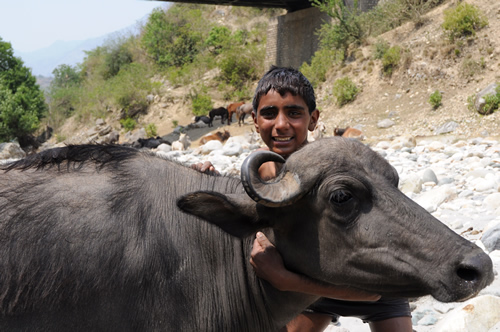
After a morning spent shuttling supplies part way to the final camp, mid-afternoon found me under the tarp with Apa, Mariam, and Akloo, who by this time were my good friends.
Our easy banter was abruptly severed by a scream, the kind of scream so panicked, so distressed that I automatically thought, "Who's dead?" Apa and Mariam turned to each other and, with fear in their faces, simultaneously said, "Bashi!" Leaping up without bothering to put on their shoes, they raced toward the source of the shriek.
Bashi was twelve, sweet and gentle-natured. She spoke with a slight stutter, and did the work of an adult even though she was very much a child. She'd been tending her family's buffalo calves, which she adored and cared for diligently, and which had to be separated from their mothers for most of the day to prevent them from drinking up all the milk.
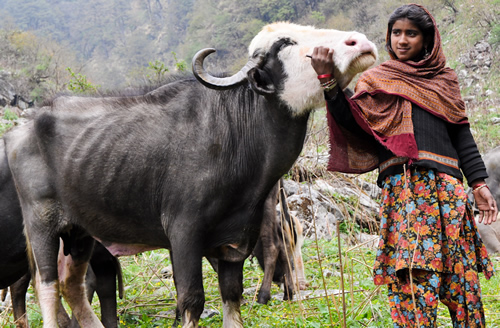
They were a few minutes uphill from the camp, in a creek-carved gorge that funneled runoff down from highest ridges. At the base of a sheer cliff, the animals clustered together, hiding from the weather, instinctually seeking cover under an overhanging rock, though not all could fit beneath it.
During the worst of the storm, Bashi huddled in close with the calves, knowing her presence helped calm them — and taking comfort from them as well. When the downpour faded to a chilly mist, she left to fetch a bundle of grass for her four-legged friends to munch on.
While she was away, the storm suddenly swirled back to life. Thunder shook the canyon. Rain exploded from the sky. At the top of the rock wall, some fifty feet directly above where the young buffaloes stood, the water rose in a small ravine. Swelling fast, it surged downhill, sweeping a dead tree off its brittle roots and flinging it over the cliff's edge. Plunging to the ground, it smashed into five of the calves.
Hurrying back with the fodder, Bashi saw the whole thing. Her scream, the one we’d heard at camp, was wrought from sheer terror. Though incredibly lucky she’d stepped away and wasn’t crushed by the tree herself, Bashi wasn't thinking about that. Fearing the calves were dead or dying, she didn't investigate, instead turning and running for the tents, her bare feet splashing through frigid puddles while she cried hysterically, screaming repeatedly for help. Her brothers, sisters, and cousins were already on their way.
The rain paused. The sight of the injured buffaloes and the shattered tree was like a collective punch in the gut to the family. As though the wind was knocked out of each of them with a wail, it took a few minutes before the shock of heartrending disbelief ebbed into action. Grief-stricken and down-to-business, my companions — even the men — wept as they triaged the animals, sorting the wounded from the well, checking the injured, and building a bonfire to keep the calves warm. The five buffaloes that had been struck were large yearlings. Two were okay, their tough black hide only scratched a little from the tree’s branches. Another two suffered blows to their bodies. The fifth had a crushed front leg. The shattered bone stuck out, and the hoof beneath it flopped around as if attached by a rubber band.
A burlap sack was warmed over the fire, then spread over the back of the broken-legged yearling to give it comfort. Lying on the ground, its foot at an unnatural angle, it was too hurt to struggle even as Chamar, Hamju, and their older brother, Gamee, straightened its leg and bound the wound with a shirt and scarf. Blood dripped from the corner of its mouth. It sank into deep lethargy. I’m not sure if it’s possible, but it looked like tears were slowly rolling from its eyes. The animal seemed like it might be dying. And the rain started falling again.
After about fifteen minutes, Bashi’s uncle, Yusuf, finally arrived. His pointy beard, dyed orange, leapt in the wind as he asked what happened, his tone both demanding and desperate. The injured buffaloes were his. While listening to the story, he dropped his umbrella, knelt on the soggy ground, and examined the yearlings. Upon seeing the broken leg, he slapped his hands to his forehead and left them there. Facing skyward, he ranted in anguish, uttering short, tormented outbursts that each ended with a pained howl.
A few minutes later Yusuf's wife, Roshni, approached with Bashi’s mother, Jamila. With calm confidence, the two women ushered their children away, back to camp or to the herds of adult buffaloes temporarily left untended. Their silver bracelets jingling, they mixed milk and turmeric powder together in a stainless steel jug then, through a green plastic tube, poured the concoction down the throats of the wounded yearlings to fortify them and deter infection.
Suddenly, the sky crackled and hail began to fall, violently, in balls the size of cherries. Jamila and Roshni sheltered under the rock overhang. With their scarf-covered heads tilted to the heavens, they watched with distressed eyes as millions of ice pellets streaked through the foggy air, the drumroll of countless tiny impacts echoing off the canyon wall. Taking it as proof that destiny was truly against them, Jamila and Roshni keened in high-pitched tones, plaintively praying to Allah with their whole souls, pleading for mercy yet willing to accept whatever fate had been had written for them. Standing beside them, and with a somewhat less fatalistic philosophy of life, I couldn't forget the fact that, had they been permitted to go to their traditional summer pasture, they wouldn't be in this canyon and the accident never would have happened.
Things looked bad for the yearling with the broken leg. She couldn’t walk, let alone climb up and over the high mountain pass to the meadow where the herd would graze for the summer. The only question in my mind was whether she’d be left behind to die, or would be put down somehow.
But Yusuf and his brother, Dhumman — Bashi and Apa’s father, and a highly respected tribal leader — wouldn’t give up on the calf so easily. Their entire lives had been devoted to caring for buffaloes, and they’d inherited all the knowledge of their people, passed down through countless generations of their ancestors. But they weren't sorcerers, and I had my doubts that they could save the poor creature.
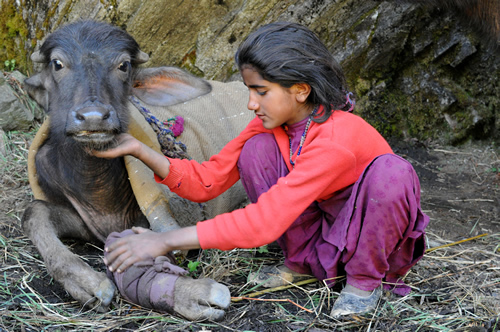
The morning after the accident was sunny and warm. As Dhumman fashioned a splint from six thin pieces of wood and some rope, Bashi sat by the yearling’s head, petting and kissing her. While Chamar, Gamee, and Roshni held the calf down, turmeric powder was poured into the wound. Yusuf applied traction to the leg, and Dhumman jimmied the bone back in. Working slowly and meticulously, Dhumman bandaged the wound, then wrapped it with a cloth. At last, the wooden splint was secured around the animal’s leg as tightly as possible. It looked perfect, and couldn't have been done better by a veterinarian.
There was only one problem: the buffalo still couldn’t walk. Though Dhumman and Yusuf succeeded in stabilizing her leg, there was no way she’d make it over the pass to the meadow. The following day, we rose before dawn, loaded up the pack animals, and faced the breath-stealing, thigh-pounding ascent to our final destination. The climb was so strenuous that the horses and bullocks struggled, forcing us to take some of their load and carry it on our own backs. The wounded buffalo, as expected, was left behind.
The view from the meadow was staggering. To the north, the gleaming, snow-clad Bandarpunch massif, some 20,000 feet high, filled the panorama. From its base, a river tumbled through a dramatically hewn canyon, its walls adorned with waterfalls. Yet despite the aura of Shangri-La, something felt wrong. After forty tough days on the trail, the brief moment of triumph at reaching their goal faded into a sense of disappointment. "It is more beautiful here than where we usually go," Apa told me, "but it isn't our home." And one of the family was missing. They hadn't forgotten the calf down below.
But at least that could be remedied.
Dhumman, his eldest son, and Yusuf's four sons headed down the mountain early the next morning. When they reached the wounded yearling, they lashed it to two poles cut from slender tree trunks. Then, in a feat worthy of Hercules, they hoisted the animal onto their shoulders and carried it back up and over the pass, 3000 feet above. Hours later, upon reaching the meadow, the yearling was clearly relieved to be back on the ground. With a little bit of help, it stood, and even hobbled a few ginger steps. By the time they’d descend in the fall, Dhumman said, the buffalo's broken bone would be healed enough for it to walk down to the lowland jungles on its own four feet.
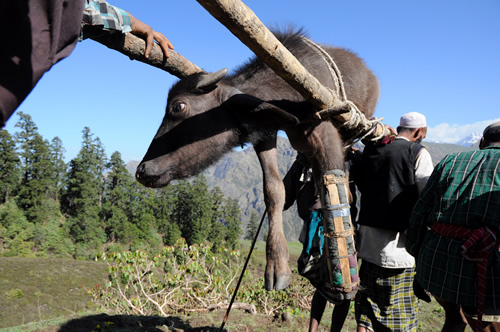
Some people to whom I've recounted this episode have suggested that the yearling was rescued because a family of poor nomadic herders couldn't afford to lose even one animal. But that's not it, not really. They did it because they love their buffaloes.
I spent forty-four days immersed in the Van Gujjars' world, living, walking, herding, and laughing with them, sharing their food, listening to their songs, and sleeping beside them. I learned not only about their culture, but about their individual dreams and fears, their personal priorities and problems. And what I remember most, not with my brain but in the core of my being, isn't their myriad skills, their abilities to perform seemingly impossible tasks, or their encyclopedic (if illiterate) knowledge of the forests they live in. It's their huge-heartedness. I expected my journey with a family of nomadic buffalo herders to be fascinating; I didn't expect it to become so profoundly personal. Struggling for the right words, I can only say that I came to love them. Deeply. For quite some time after I hiked out of the Himalayas, leaving my family up in their alpine bugyal, I literally, physically ached to see them again. Now, many months later, the ache has subsided, though it grips me spontaneously every now and then.
As the tentacles of globalization and modernization creep into the most remote places on the planet, squeezing the age-old ways of life out of them, I was hoping to emerge from the migration with some answers to questions I’ve been probing for years about dilemmas concerning the survival and the value of traditional cultures. Answers still eluded me, but I did gain a deeper understanding of the questions themselves. My experiences among the Van Gujjars, especially my feelings for those in my nomadic family, inspire me to continue exploring those dilemmas through writing and photography, and sharing what I learn through both my published work and the slide presentations I give to students at schools across the United States. As unique cultures disappear and humankind becomes increasingly homogenized, I want my work to serve as a reminder of the myriad possibilities of what it can mean to be human. And of course there's the hope that the more people know about this little-known clan, the more the world will care about them.
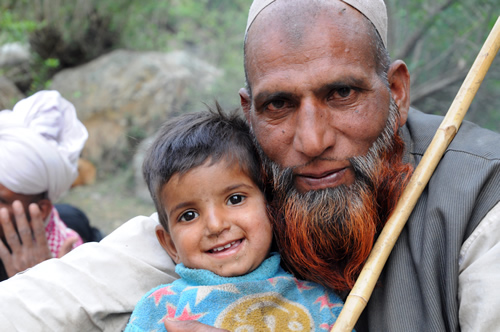
I don't know what's going to happen to my nomadic family. They and other Van Gujjars who face losing their grazing territory to parklands are currently appealing to have their traditional rights to those meadows and forests officially recognized by the authorities that control them. If they're successful, my family should be able to return to their traditional bugyal next summer and long into the future. If they're denied, they’ll face severe hardships, and will have to scramble once again to find pasture in the mountains.
This year, the difficulties — most of all the uncertainties — reached traumatic proportions. Dhumman and Jamila told me that they feared for their future. "If we can't migrate to the meadows, the buffaloes will die. And if they die, we die with them," Dhumman said. For the first time, they began to consider the benefits of settling in a village — once unthinkable to anyone in their proudly nomadic tribe. "We'd lose a lot," Jamila admitted, "but at least we'd know where we are."
Apa, their daughter, disagreed. She'd once lived in one of the government-built villages with her husband, whose family had been relocated from the Shivaliks. And she hated it. "Living in a village is like being in prison," she said with palpable disgust. Despite the hardships of nomadic life, she embraced it fully, having had a taste of the alternative. "I just want to keep living the way we always have. Is that asking too much?"
It might be. But I hope not.
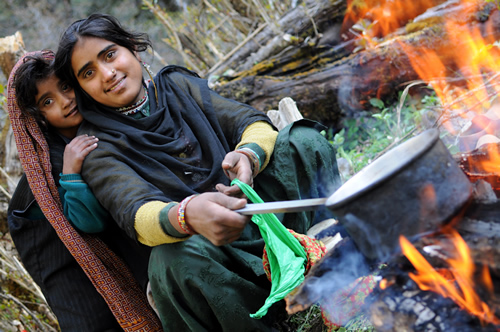
Michael Benanav is a freelance writer and photographer for The New York Times, Lonely Planet, National Geographical, The Christian Science Monitor Magazine, and many other
publications. He’s also the author of many highly-praised
books, including Himalaya Bound: One Family's Quest to Save Their Animals ― And an Ancient Way of Life.
|
